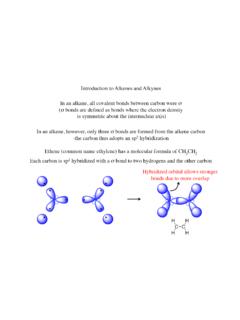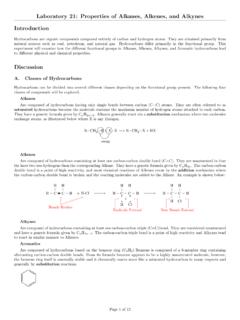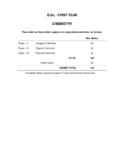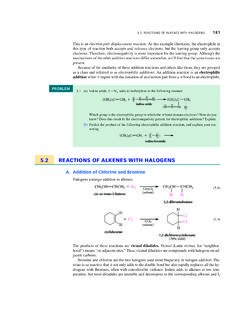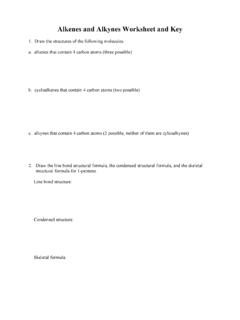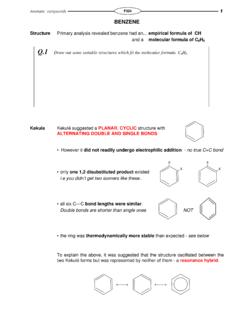Transcription of HYDROCARBONS 365 - National Council Of Educational ...
1 365 HYDROCARBONSUNIT 13 After studying this unit, you will beable to name HYDROCARBONS according toIUPAC system of nomenclature; recognise and write structuresof isomers of alkanes, alkenes,alkynes and aromatichydrocarbons; learn about various methods ofpreparation of HYDROCARBONS ; distinguish between alkanes,alkenes, alkynes and aromatichydrocarbons on the basis ofphysical and chemical properties; draw and differentiate betweenvarious conformations of ethane; appreciate the role ofhydrocarbons as sources ofenergy and for other industrialapplications; predict the formation of theaddition products ofunsymmetrical alkenes andalkynes on the basis of electronicmechanism; comprehend the structure ofbenzene, explain aromaticityand understand mechanismof electrophilic substitutionreactions of benzene; predict the directive influence ofsubstituents in monosubstitutedbenzene ring; learn about carcinogenicity term hydrocarbon is self-explanatory which meanscompounds of carbon and hydrogen only.
2 Hydrocarbonsplay a key role in our daily life. You must be familiar withthe terms LPG and CNG used as fuels. LPG is theabbreviated form of liquified petroleum gas whereas CNGstands for compressed natural gas. Another term LNG (liquified natural gas) is also in news these days. This isalso a fuel and is obtained by liquifaction of natural , diesel and kerosene oil are obtained by the fractionaldistillation of petroleum found under the earth s gas is obtained by the destructive distillation of gas is found in upper strata during drilling of oilwells. The gas after compression is known as compressednatural gas. LPG is used as a domestic fuel with the leastpollution. Kerosene oil is also used as a domestic fuel butit causes some pollution. Automobiles need fuels like petrol,diesel and CNG.
3 Petrol and CNG operated automobilescause less pollution. All these fuels contain mixture ofhydrocarbons, which are sources of energy. Hydrocarbonsare also used for the manufacture of polymers likepolythene, polypropene, polystyrene etc. Higherhydrocarbons are used as solvents for paints. They are alsoused as the starting materials for manufacture of manydyes and drugs. Thus, you can well understand theimportance of HYDROCARBONS in your daily life. In this unit,you will learn more about CLASSIFICATIONH ydrocarbons are of different types. Depending upon thetypes of carbon-carbon bonds present, they can beclassified into three main categories (i) saturatedHydrocarbons are the important sources of energy. NCERTnot to be republished366 CHEMISTRY(ii) unsaturated and (iii) aromatichydrocarbons.
4 Saturated hydrocarbonscontain carbon-carbon and carbon-hydrogensingle bonds. If different carbon atoms arejoined together to form open chain of carbonatoms with single bonds, they are termed asalkanes as you have already studied inUnit 12. On the other hand, if carbon atomsform a closed chain or a ring, they are termedas cycloalkanes. Unsaturated hydrocarbonscontain carbon-carbon multiple bonds double bonds, triple bonds or both. Aromatichydrocarbons are a special type of cycliccompounds. You can construct a large numberof models of such molecules of both types(open chain and close chain) keeping in mindthat carbon is tetravalent and hydrogen ismonovalent. For making models of alkanes,you can use toothpicks for bonds andplasticine balls for atoms.
5 For alkenes, alkynesand aromatic HYDROCARBONS , spring models canbe ALKANESAs already mentioned, alkanes are saturatedopen chain HYDROCARBONS containingcarbon - carbon single bonds. Methane (CH4)is the first member of this family. Methane is agas found in coal mines and marshy places. Ifyou replace one hydrogen atom of methane bycarbon and join the required number ofhydrogens to satisfy the tetravalence of theother carbon atom, what do you get? You getC2H6. This hydrocarbon with molecularformula C2H6 is known as ethane. Thus youcan consider C2H6 as derived from CH4 byreplacing one hydrogen atom by -CH3 on constructing alkanes by doing thistheoretical exercise , replacing hydrogenatom by CH3 group. The next molecules willbe C3H8, C4H10 ..These HYDROCARBONS are inert undernormal conditions as they do not react withacids, bases and other reagents.
6 Hence, theywere earlier known as paraffins (latin : parum,little; affinis, affinity). Can you think of thegeneral formula for alkane family orhomologous series? The general formula foralkanes is CnH2n+2, where n stands for numberof carbon atoms and 2n+2 for number ofhydrogen atoms in the molecule. Can yourecall the structure of methane? According toVSEPR theory (Unit 4), methane has atetrahedral structure (Fig. ) which ismultiplanar, in which carbon atom lies at thecentre and the four hydrogen atoms lie at thefour corners of a regular tetrahedron. AllH-C-H bond angles are of .In alkanes, tetrahedra are joined togetherin which C-C and C-H bond lengths are154 pm and 112 pm respectively (Unit 12). Youhave already read that C C and C H bondsare formed by head-on overlapping of sp3hybrid orbitals of carbon and 1s orbitals ofhydrogen Nomenclature and IsomerismYou have already read about nomenclatureof different classes of organic compounds inUnit 12.
7 Nomenclature and isomerism inalkanes can further be understood with thehelp of a few more examples. Common namesare given in parenthesis. First three alkanes methane, ethane and propane have onlyone structure but higher alkanes can havemore than one structure. Let us writestructures for C4H10. Four carbon atoms ofC4H10 can be joined either in a continuouschain or with a branched chain in thefollowing two ways :Fig. Structure of methaneButane (n- butane), ( 273 K)I NCERTnot to be republished367 HYDROCARBONSIn how many ways, you can join fivecarbon atoms and twelve hydrogen atoms ofC5H12? They can be arranged in three ways asshown in structures III Vstructures, they are known as structuralisomers. It is also clear that structures I andIII have continuous chain of carbon atoms butstructures II, IV and V have a branched structural isomers which differ in chainof carbon atoms are known as chain , you have seen that C4H10 and C5H12have two and three chain isomers structures of different chain isomersof alkanes corresponding to the molecularformula C6H14.
8 Also write their (i) CH3 CH2 CH2 CH2 CH2 CH3n-Hexane2-Methylpentane3-Methylpentan e2,3-Dimethylbutane2,2 - DimethylbutaneBased upon the number of carbon atomsattached to a carbon atom, the carbon atom istermed as primary (1 ), secondary (2 ), tertiary(3 ) or quaternary (4 ). Carbon atom attachedto no other carbon atom as in methane or toonly one carbon atom as in ethane is calledprimary carbon atom. Terminal carbon atomsare always primary. Carbon atom attached totwo carbon atoms is known as carbon is attached to three carbonatoms and neo or quaternary carbon isattached to four carbon atoms. Can you identify1 , 2 , 3 and 4 carbon atoms in structures III2-Methylpropane (isobutane)( K)Structures I and II possess samemolecular formula but differ in their boilingpoints and other properties.
9 Similarlystructures III, IV and V possess the samemolecular formula but have differentproperties. Structures I and II are isomers ofbutane, whereas structures III, IV and V areisomers of pentane. Since difference inproperties is due to difference in theirIIIP entane (n-pentane)( 309 K)2-Methylbutane (isopentane)( 301 K)IV2,2-Dimethylpropane (neopentane)( K)V NCERTnot to be republished368 CHEMISTRYto V ? If you go on constructing structures forhigher alkanes, you will be getting still largernumber of isomers. C6H14 has got five isomersand C7H16 has nine. As many as 75 isomersare possible for structures II, IV and V, you observedthat CH3 group is attached to carbon atomnumbered as 2. You will come across groupslike CH3, C2H5, C3H7 etc. attached to carbonatoms in alkanes or other classes ofcompounds.
10 These groups or substituents areknown as alkyl groups as they are derived fromalkanes by removal of one hydrogen formula for alkyl groups is CnH2n+1(Unit 12).Let us recall the general rules fornomenclature already discussed in Unit of substituted alkanes canfurther be understood by considering thefollowing problem:Problem structures of different isomeric alkyl groups corresponding to the molecular formulaC5H11. Write IUPAC names of alcohols obtained by attachment of OH groups at differentcarbons of the of C5H11 groupCorresponding alcoholsName of alcohol (i) CH3 CH2 CH2 CH2 CH2 CH3 CH2 CH2 CH2 CH2 OHPentan-1-ol(ii) CH3 CH CH2 CH2 CH3CH3 CH CH2 CH2 CH3 Pentan-2-ol||OH(iii) CH3 CH2 CH CH2 CH3CH3 CH2 CH CH2 CH3 Pentan-3-ol ||OHCH3CH33-Methyl-||butan-1-ol(iv) CH3 CH CH2 CH2 CH3 CH CH2 CH2 OH CH3CH3 2-Methyl- ||butan-1-ol(v) CH3 CH2 CH CH2 CH3 CH2 CH CH2 OHCH3CH32-Methyl-||butan-2-ol(vi) CH3 C CH2 CH3CH3 C CH2 CH3||OHCH3CH32,2- Dimethyl-||propan-1-ol(vii) CH3 C CH2 CH3 C CH2OH || CH3CH3CH3CH3OH3-Methyl-| ||| butan-2-ol(viii)










